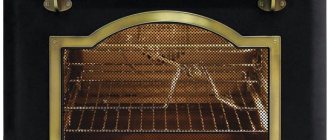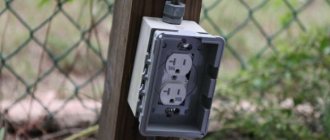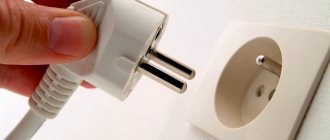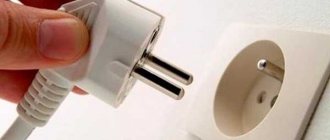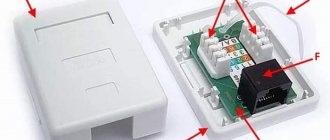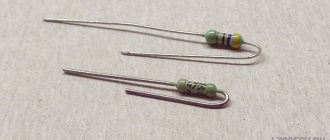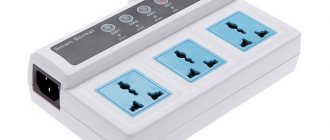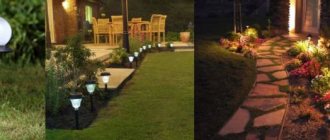12/29/2016 master
Everyone has had cases when, while relaxing in a country house or at the dacha, the need arose to connect a tape recorder on the street. And to do this, I had to throw an extension cord from home, which is not always convenient. And this is where street sockets come in handy, as they will greatly simplify connecting electrical appliances outside the home.
Outdoor socket
Sockets of this type are intended for use outside the house. Their presence will make your garden more comfortable and convenient for friendly gatherings. Our article will tell you how to choose the most optimal outdoor model, as well as install it yourself.
Design features of outdoor socket models
We are all familiar with the sockets that our home is full of. But only a few people know that similar devices can be installed outside the house. And exactly, how can you even think of installing a socket in the garden if it sparkles at the first rain? It turns out that there is a special street block that will not only withstand all the hardships of street existence, but will also allow you to provide either high-quality and safe lighting for your garden, or simply connect any electrical appliance.
Note! The outdoor model differs from the indoor model in its high degree of moisture protection (IP65).
Socket design
Due to the fact that these sockets are waterproof, this fact had a significant impact on the design features of the products. All modern models with a high degree of moisture protection IP65 have:
- thermoplastic body, which is characterized by increased resistance to flammable and chemical substances;
- The product block is equipped with a special protective membrane. In addition, the outdoor socket and its protective membrane are made taking into account the grounding contact and the housing cover when installing the product yourself;
- all contacts are bronze and have a high level of conductivity;
- presence of flange and gutter. They are necessary to remove moisture past conductive parts;
- 100% tightness of cable entries. They are usually equipped with rubber or silicone linings.
Any street model that can be found on sale today will definitely have such a structure.
How to install an outlet on the street - UK Energotechservice LLC
Outdoor sockets are designed for use outside the house, which provides convenience in connecting equipment. In the article we will consider the features, technical characteristics of devices and installation rules.
Features of installing street sockets
Outdoor sockets are manufactured taking into account safety parameters and protection in the external environment from adverse events. Their installation is practical for connecting lawn mowers, garden equipment and appliances to the electrical network. This simplifies the task of using wiring and carrying.
Outdoor electrical sockets are usually made of high quality steel, but all additional elements are made in accordance with standard safety regulations. Such devices are installed on a solid base, for example, on concrete, soil or tiles, as well as in gazebos, on a veranda or platform.
Very often, clients prefer to install electrical devices to control the switching on of street lighting. This is necessary so that in the evening you can easily turn on all the lights in the yard, as well as adjust the brightness of the light bulbs in the garden. As a rule, you can manage the overall system in several ways:
- remote control using a computer connection;
- the presence of a switch or socket block inside the house;
- All electrical switches and switches are located outside the house.
The choice of one of the control systems depends on the characteristics of the individual model, as well as its parameters, illuminated area, and so on. It is worth noting that in a large area it is easier to control everything remotely from home, and in a small area you can install an outdoor outlet.
All control systems are shown to make it easier for the owner to decide on an outdoor electrical installation system. It is best to install a block of street sockets, which will allow you to control all devices, both lighting and connection items, such as electric saws, mowers, and so on, from one place.
One of the varieties is the purchase of waterproof sockets, which ensure the safety of the electrical network from the adverse effects of natural phenomena and factors. For example, a high-quality device must withstand temperature changes and be protected from moisture and dust, which is very important in places where excavation and irrigation are carried out.
Outdoor waterproof sockets must be made in such a way as to avoid external interference, and also so that children cannot reach them.
One of the safety rules is to install a metal case that is securely fastened. It can be designed for 2 or 4 sockets, which are standard connectors.
What to choose from
Various modifications with IP65 waterproof rating are presented in a fairly wide range. These devices, first of all, differ from each other in their housings, which can be:
- rubber;
- rubber. They are used for cable extension cords and their accessories;
- completely poured out.
Outdoor socket in the wall
In addition, the division is not only based on the characteristics of the body, but also on other grounds. These features should have a direct impact on your choice. Therefore, before going to the market, you need to have at least a little idea of what you will have to deal with. The first thing you should pay attention to when choosing waterproof sockets (IP65) is the method of their installation. Today, such products can be installed in two ways:
- laying on the surface. Overhead waterproof models are considered more profitable, since it will be much easier to install them yourself. They are usually mounted on the wall of a building. Such models have a hermetically sealed housing. At the same time, they are equipped with a hinged lid that also protects the openings of the socket itself from moisture getting into them during rain or watering the garden plot, as well as from morning dew;
Note! Waterproof overhead sockets are considered the most optimal solution for a summer house and a private home.
Overhead sockets
- cutting into the surface. To install a mortise block into the wall, you need to make a special hole with your own hands, verified according to all the necessary parameters. Despite the difficulties with the installation process, mortise devices look more aesthetically pleasing than overhead models. If desired, they can even be disguised as the external facade of the building.
Note! For mortise street sockets you will need an additional special socket box. In this case, insulation will also have to be installed.
Mortise street socket
It should also be noted that the appearance of different models may be different. Therefore, you will also need to focus on this parameter in order to choose a more optimal option for yourself. The last point, which is of no small importance for a well-chosen device of this type, will be the manufacturer. Today on the market and in stores you can find various devices from domestic and foreign manufacturers. You need to be especially careful and demanding when choosing Chinese models. After all, here you can buy not very high-quality products. It is better to buy products from trusted brands and manufacturers who have been working in this market segment for several years.
Useful uses of plastic bottles in the country (Part 11)
In this series of articles I talk about how you can use old plastic bottles for your garden and garden. From all the many tips, I select only the most practical ones that could be useful to me.
For winter preservation of barrels and ponds
Plastic cans and two-liter bottles can be used to preserve barrels and ponds before the winter cold. To prevent ice from breaking the water container, it is necessary to compensate for the increasing volume. Plastic containers are perfect for this.
There are two main methods of volume compensation using bottles.
1.1 Float system
This system involves immersing the bottle in water 3/4 of its volume. In this case, the neck with the lid loosely screwed on should be above the surface of the water. During freezing, the ice will compress the container, due to which the pressure on the walls of the barrel (pond) will become less.
To prevent the bottle from floating to the surface, you need to attach an anchor to it. It can be made from brick, stone or other heavy object.
1.2 Immersion system
This system differs from a float in that the bottle is completely immersed in water. To do this, we fill the container with sand or stones, and then drown it in a barrel or pond. When the water begins to freeze, the ice will compress the bottle, thereby compensating for a small part of the volume.
Considering that when water freezes, its volume increases by about 8%, the number of bottles and floats must be calculated based on the initial volume of the barrel (pond).
Protective cover for sockets
You can make a protective cover for outdoor outlets from plastic cans and bottles. It will help protect installation electrical equipment from rainwater and snow.
There are many different designs, but I consider three types to be the most practical:
2.1 Classic “visor”
The visor is considered the simplest protective structure. The process of its creation consists of four stages:
- The neck and bottom of a two-liter plastic bottle are cut off;
- The resulting cylinder is cut horizontally and straightened into a rectangle. To ensure that the plastic retains its shape, it is ironed;
- From the resulting canvas we cut out a square with an area 2 times larger than that of the socket;
- We attach our visor above the socket so that the electrical equipment is completely covered. When using the socket, the visor bends upward.
This is not the most reliable design, but its creation will take no more than 10 minutes.
2.2 "Feeder"
This design is very similar to a bird feeder. A hole the size of a rosette is cut in the front wall of the bottle (preferably rectangular in shape). A hole is cut in the opposite wall for wires and fasteners.
Next, the bottle is attached to a wall or pole, after which a socket is installed in it. The joints between the wall and the bottle are sealed with sealant.
This design is much more reliable than the “visor”, but requires installation/disassembly of the socket.
2.3 Sealed protection
The operating principle of this protection is shown in the figure above. This is the most reliable design. However, to create it you will have to find a plastic jar with a screw-on lid.
We attach the cover to the place where the socket will be installed (the wires should already be routed there and the fastening should be prepared). We coat the joints with sealant. Next, we mount the socket itself, and next to it we hang our jar on a rope, which will act as a lid.
To prevent condensation from accumulating in a confined space, a small hole must be made in the lid.
That's all, our defense is ready. In order to close the socket from the rain, just screw the jar into the lid. This design allows you to leave electrical equipment even for the winter.
Protective cover for locks
One of the most popular ways to use a plastic bottle is to create a protective cover for a padlock. The design gained popularity due to its simplicity and practicality. It will take no more than 2-3 minutes to create. We only need a bottle and scissors.
For containers with a volume of 0.5 - 2.5 (depending on the size of the lock) liters, the bottom is cut off, and a cutout is made in the back side as thick as a loop on which the lock will hang. The bottle cap is screwed tightly, and the sharp edges are sanded with sandpaper. That's all, our defense is ready.
The resulting cover fits onto a closed lock to protect it from rainwater and snow.
Arrangement of vertical beds
If there is not enough space for a vegetable garden on your summer cottage, you can organize vertical beds. This method has long been used abroad and is gradually being adopted by our gardeners.
Pots for making such beds can be bought, or you can make them from transparent plastic bottles. It will take no more than half an hour to create the entire structure. We only need plastic bottles, scissors and an awl.
- Cut off the bottom of a 2-liter bottle;
- Screw the lid tightly, and make 3-4 small drainage holes in the neck;
- Next, we fix the bottle on a fence, wall or pole;
The first level of our garden bed is ready. Now we fill the bottle with soil and cut a hole in which we will plant the plant. We do all the other floors in the same way, placing the bottles on top of each other.
Thus, we get a multi-story bed that takes up no space at all. Thanks to its design, the plants are not shaded and are well ventilated.
Moisture protection is an important selection parameter
Separately, it is worth considering the moisture-proof properties of the products, since they will be forced to work in clearly unfavorable conditions. If the moisture resistance is lower than required for its purpose (for example, IP65), then there is a risk of a short circuit due to moisture or dirt penetrating into the housing of the street outlet. And this poses a threat to the lives and safety of people.
Outdoor socket in electrical panel
The moisture resistance class (for example, IP65 and below) for street switches and sockets is determined by the International Electrotechnical Commission. But here you need to understand that such a device can be installed outdoors in different places:
- in the electrical panel. In this place, the device will have additional protection in the form of an electrical panel cover. Therefore, there is no need to buy sockets with a high water resistance class (IP65). Here, a degree of protection from moisture and dust at the IP44 level will be quite sufficient;
- directly on the wall of the house. Here, in order for the device to effectively withstand dirt and moisture, the waterproof class must be higher - about IP54/55, or even IP65.
Today, the most popular models of outdoor sockets are those with a waterproof rating of IP65. To understand what these letters and numbers mean, here is a breakdown of the degree of protection of outdoor devices from moisture and dust:
- the abbreviation IP stands for International Protection, which translated from English means international protection;
- the first digit of the marking indicates the level of protection of the device from dust;
- the second digit indicates the level of protection of the device from moisture.
As a rule, all models of street sockets have a fairly high moisture resistance class. Here the choice must be made only in favor of a larger or smaller value. Moreover, it must be remembered that the higher the moisture resistance, the more expensive the device will be. Therefore, if there is no great need to protect the outlet from moisture (for example, it is installed in an electrical panel), then you can save money and purchase a less protected model.
Outdoor motion sensors
An external motion sensor can add comfort, safety and convenience to your home. When you return home in the dark, it immediately senses your movements as soon as you approach - it turns on the external lighting. You don't have to look for keys in the dark or go through things that are out of sight. An outdoor motion sensor will provide security because you will know if someone is approaching your home and you will be able to see who it is. It can also deter thieves by creating a well-lit area where they can't hide and won't want to try to break into the house.
These devices are usually adjusted in sensitivity and direction of angle so that they only respond to your property and not to movement on the street or in a neighbor's yard.
- Author: Andrey
Rate this article:
- 5
- 4
- 3
- 2
- 1
(2 votes, average: 1 out of 5)
Share with your friends!
Where are they used?
Outdoor sockets are used:
- in garages;
- at car washes and vehicle parking;
Waterproof outdoor wall socket
- in the local area, as well as dachas and country houses;
- on construction sites;
- as an element of the lighting system of squares, parks and public gardens. Here they are used for additional connection of equipment, for example, a sprayer.
Note! Only those models of waterproof sockets that are designed specifically for indoor use can be installed indoors. This ban is due to the fact that outdoor models will always have a higher water resistance class.
General safety rules
Safety principles for connecting outdoor sockets:
- each socket on the street must have a protected circuit breaker at a height under the visor;
- for additional safety, the electrical panel must have its own circuit breaker for quickly disconnecting sockets on the street;
- To install sealed outlets, the protected grounding cable must be fire-resistant and solid. It is prohibited to connect small cable wires to an extension cord outdoors;
- The socket must be unplugged after use.
Choosing the right location
After you have chosen the socket you need from the available assortment, you need to select the location for its installation. Remember that a correctly selected placement location will allow you to operate the product for the entire period established by the manufacturers. But placement in the wrong place can in the near future negate all the advantages of this type of device. When determining the location of street-type outlets, you must be guided by the following requirements:
- devices must be placed under the visor. Its role can be played by either a roof overhang or a canopy over the porch;
- It is recommended to install the device in protective boxes or electrical panels;
- The height of the socket must be selected correctly. This way you can avoid excessive flooding of the device or its flooding.
Option for placing a street outlet
Even despite the high degree of protection of the product from moisture, prolonged and constant flooding can still lead to leakage of sealed elements and, as a result, failure of the outlet. Therefore, in order to protect yourself and your loved ones from the risk of electrical injury, the choice of location for this device must be carried out according to all the rules, taking into account all regulations.
Providing energy to water bodies
The best way to provide energy to fountains and water feature lighting is to use low voltage circuits. This usually means 12 volts - the same voltage as car batteries. You can buy entire systems that include wiring, lighting and a transformer. The latter connects to a standard household outlet and converts electricity into 12 volt direct current. Using this device outdoors and in damp places is completely safe because it will not shock you or your pets.
The transformer must be connected to a circuit that is protected by the RCD safety function. This additionally protects the scheme itself, as well as its users. The installer must always follow the instructions that come with the low voltage system and explain its installation and use.
Connection rules
When independently connecting street-type outlets to the power supply network, you must adhere to the following rules:
- choose the right location for the device;
- selection of the optimal option for conducting, grounding and connecting the cable.
All these actions must be performed taking into account the wiring parameters in the house. The process of installing this type of product (mortise model) with your own hands is as follows:
- First we make an inlet hole. To do this, you can use a drill and special attachments;
- Next, we place the wiring as close as possible to the internal outlet;
- then we attach a socket box with protective clamps for the device to the outlet space;
- Next, we fix the atmospheric pressure protection system in the box;
- after that we lay the wires to the connection point. For this purpose, a protective shutdown pass is used (if necessary).
DIY socket installation
Overhead models are much easier to install. Here you only need to attach them with fasteners to the wall in the right place. All manipulations with wires must be carried out in accordance with the requirements of street wiring. This will reliably protect the wiring from moisture and dirt. The cable must be well protected. Therefore, to protect it, you can use a shell made of polymer or PVC plastic. At the same time, all actions for organizing wiring for mortise and overhead models are carried out according to the same scheme.
Cabling
When laying cables underground, you should keep in mind that such work is regulated by the PUE (Electrical Installation Rules). If installation is carried out directly into a trench, then the only option permitted by the PUE is a special armored cable for laying in the ground (for example, VbbShV, AVBbShv, PvBbShv). In swampy areas, on highly heaving and corrosive soils, it is strictly not recommended to lay cables directly into the ground. Laying other types of cables, for example VVG, is possible only in special corrugations or pipes, regardless of soil characteristics. Single-wall and double-wall products made of HDPE (low-density polyethylene) are considered optimal for cable protection. This material has good electrical insulating properties, high strength and durability, its service life is up to 50 years. Laying cables in steel pipes is strictly prohibited. When determining the cable route, you need to take into account the requirements of the PUE for safe distances to various objects. Thus, you cannot lay cables closer than 1 m from communications: water supply, sewerage, drainage system, gas pipeline. It is undesirable to cross with other cables and pass under areas with heavy ground load or frequent excavation work. The distance to large trees should be at least 2 m, shrubs - 0.75 m, buildings - at least 0.5 m. The minimum cable laying depth according to the PUE is 0.7 m; on cultivated lands and for high-power cables it is advisable to increase it up to 0.9–1 m. It should be taken into account that the depth of the trench should be greater, since a sand cushion 10 cm thick is placed at its bottom. The cable must be solid, without joints, along the entire length of the installation; the corrugation or pipe must also be solid or with a minimum number of sealed connections. When laying the cable, you must ensure that it lies freely, without tension. After finishing the work, it is covered with a 10 cm layer of sand and soil. A warning tape is laid across the soil surface.
Never leave outdoor outlets energized when you are not using them. Make it a rule to turn on the current immediately before connecting electrical equipment and turn it off immediately when you finish work.
Source
Structural elements
Decorative lathing
Recently, almost all gazebos are sold with wooden sheathing. This is not only beautiful and aesthetically pleasing, but also allows you to achieve the following effects:
The grille partially blocks wind and rain.
A good atmosphere is created inside, especially with a large number of people, when such bad weather is not an obstacle to relaxation.
People inside the gazebo are not visible, but they, in turn, perfectly see everything that is happening on the street. This is very convenient in those moments when you want to close yourself off from the attentive gaze of others.
Sheathing with polycarbonate, clapboard or boards
If the design of the building allows you to attach cladding material to it, then you can completely protect yourself from any natural disasters.
As cladding, you can use polycarbonate slabs, lining of any class or ordinary edged boards.
Two finishing options are possible:
- “Tightly” close the walls.
- Partially close the walls.
The second option looks more interesting, but is less effective. Rain and wind will easily pass through the casing. The first option will completely cover the gazebo, but will do so to the detriment of its appearance.
Jiuwan car cover
A voluminous awning that does not allow rain and dirt to pass through will help preserve the appearance of your favorite car. The main thing is to choose a larger size.
The accessory will also come in handy in the summer, since it is made of dense synthetic fabric with metallization and reflects the sun's rays. He is also not afraid of snow.


